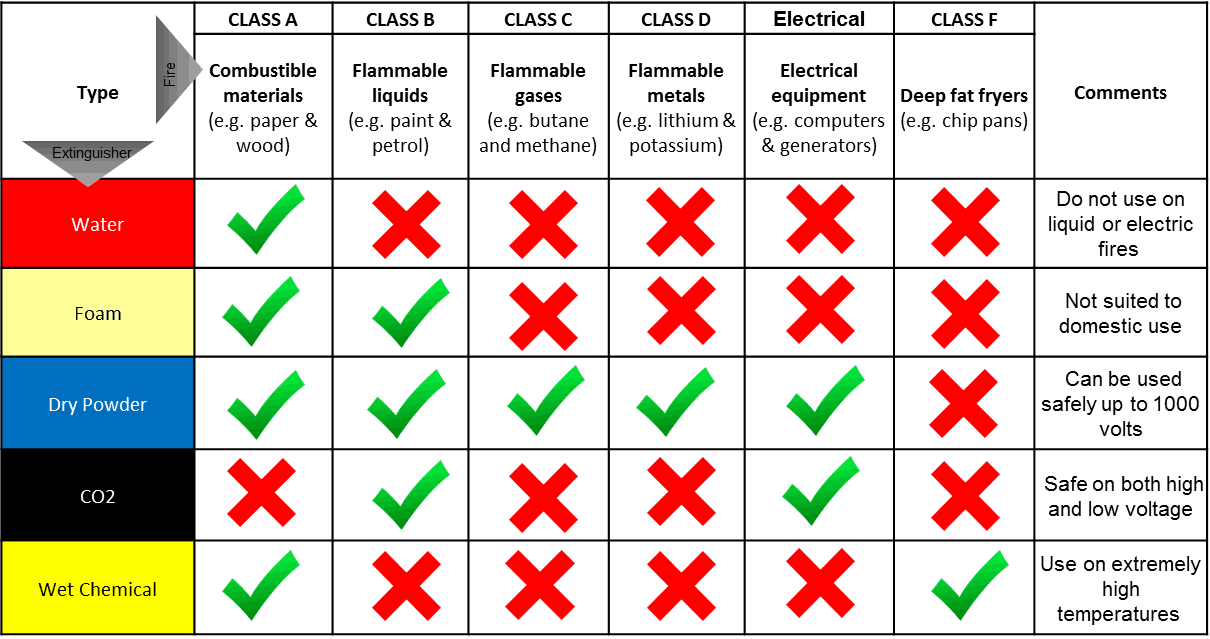
What are the five categories of fire extinguishers? Understanding fire extinguisher classes Class A extinguishers will put out fires in ordinary combustibles such as wood and paper. Class B extinguishers are for use on flammable liquids like grease, gasoline and oil.
Class C extinguishers are suitable for use only on electrically energized fires. A large part of safety is being prepared for accidents and emergencies such as a fire. Different types of fire extinguishers are designed to fight different types of fire. The three most common types of fire extinguishers are: air pressurized water , CO ( carbon dioxide ), and dry chemical. The following table provides information regarding the type of fire and which fire extinguisher should be used.
Types of Extinguishers 1. An ABC powder fire extinguisher has numerous advantages as it is. A carbon dioxide fire extinguisher (CO2). The wet chemical extinguisher is a specialized type.

Each type of fire extinguisher is suitable for different types of burning media and will have a fire rating based on the volume of fire that they are capable of extinguishing. Below is an overview of each type of fire extinguisher including its rating and suitable uses. Fire Extinguisher Classes and Suitability.
This extinguisher removes the chemical reaction of a fire, and is the most used of all fire extinguishers because of its versatility across multiple classes. You should have the right types of fire extinguisher for your premises, or you may not meet current regulations. The various types of fire extinguisher put out fires started with different types of fuel – these are called ‘classes’ of fire. Water and Foam fire extinguishers extinguish the fire by taking away. Dry Chemical fire extinguishers extinguish the fire primarily by interrupting.

There is no official standard in the United States for the color of fire extinguishers, though they are usually re except for class D extinguishers which are usually yellow, water and Class K wet chemical extinguishers which are usually silver, and water mist extinguishers which are usually white. Non-Toxic and Non-Corrosive. To assist people quickly identify the right type of fire extinguisher, pictographs are used to represent different classes of fire. Not all fires are the same. Powder fire extinguishers are ideal for use in mixed risk environments and offer excellent all round fire protection.
With a unique class C rating, powder fire extinguishers are the only effective solution for fires involving flammable gases. Class A extinguishers are rated for fires that involve ordinary household items such as woo cloth, paper, rubber and plastics. There are three general classes of residential fire extinguishers. The numerical rating on class A extinguishers represents the capacity in terms of an equivalent volume of water. This type of fire extinguisher is simple to use.
However, water fire extinguishers are only suitable for class A fires, which are fires involving solids. Like burning woo paper, plastics etc. Never use this type of fire extinguisher on or near electrical equipment. A recent development in the types of fire extinguishers is water mist.
Class D Class D fire extinguishers are used for various types of flammable metals. A class D fire extinguisher can contain sodium chloride, graphite, or copper powder. Fire extinguishers with a Class A rating are effective against fires involving paper, woo textiles, and plastics. The primary chemical used to fight these fires is monoammonium phosphate, because of its ability to smother fires in these types of materials.
Class B fires involve flammable or combustible liquids such as gasoline, kerosene, grease and oil. Class C fires involve electrical equipment, such as appliances, wiring,. PKP should be a last resort solution to extinguishing the fire due to its corrosive tendencies.
Class A fires are commonly put out with water or monoammonium phosphate.
No comments:
Post a Comment
Note: only a member of this blog may post a comment.